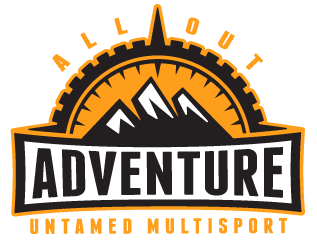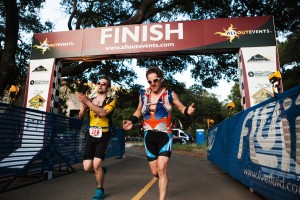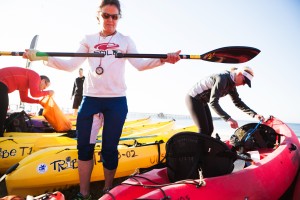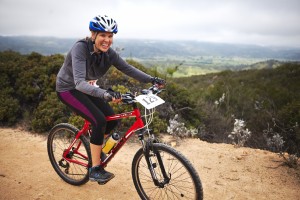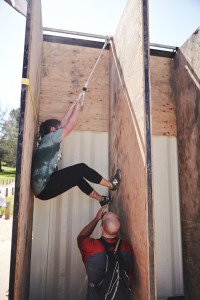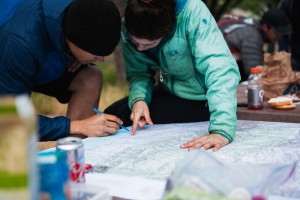“At the end of this race I felt more accomplished than I ever felt in my entire life! I had been feeling so unmotivated in my activities lately & this race has totally given me that old spark back.” – 2013 racer review
All Out is committed to providing you with the finest race experience you can have – selecting heart-stoppingly beautiful venues and uber fun trails, always favoring single track above dirt and asphalt when we can, and making courses dynamic and fluid, like a real trek through the most beautiful stuff the region has to offer.
We want you to have a good time and truly see what you’re made of, and we promise never to frustrate you with course design or stupid elements.
The Components of the Race
Teamwork:
For our sprints, we require a two-person team, for the longer races – solos up to four people on a team. Why teams? For one reason, it’s more fun, and for another, you’re there to take care of each other. A lot of times your race time will be faster because you’ll be pushing your teammate (both mentally and literally).
Coming across the finish line with your friend, loved one, or maybe just the partner you found can make the experience. Many people get creative, they’re ride one another, hold hands, skip, leap frog . . . and that’s just the finish.
Sharing the experience with someone makes it that much better. You need to stay within 100 feet of each other at all times, no dropping or strategic waiting – you both pull the same load and experience the same race.
Kayaking/swimming:
This is often the big stopper for adventure race would-bes because they do not have much experience with water. But no fear, most people’s weakest part of the race is this one.
We provide two-person sit-on-top kayaks if you don’t bring your own, which no one is really great at on lakes anyway. Just grab one, jump on and start paddling.
You’ll get there. The two of you will figure out a rhythm and when one gets tired, the other picks up the slack.
Biking:
Our races favor fun single track mountain biking – which means you need to be pretty comfortable on the bike. You don’t need to be an expert, though. If you’re used to riding a bike on paths, you may have to get off and push (steep climbing and descents can be intimidating), but the fact that you’re in a “race” will help push you a little harder than you knew you could go, and that’s part of the joy.
Your commuter bike, if it’s got big tires, can get you through the race, but having at least a single-suspension mountain bike will make it more comfortable and fun. Bikes are available locally to rent, just ask us!
“Running”:
AR always bills the foot section as “running” but for most teams, even the fast ones, it’s more often jogging or walking/hiking.
Because our races are usually situated in hilly locations, you’ll be doing a lot of up and down, maybe some bushwacking, and maybe some light rock scaling.
You’re likely carrying a pack with you, too. We don’t expect four-minute miles, and you shouldn’t either. Please take the time to check out the view as you go!
Special challenges:
In our sprint races, we clearly mark the trail with arrows and flagging tape – in longer AR experiences, you need to find your own way.
In order to keep that element of thinking, teamwork, and surprise, All Out is always coming up with fun little challenges on-course that involve skills you didn’t know you had.
Maybe it involves supervised ropes, puzzle-solving, cargo-net climbing, or even water slides!
Navigation:
This is the biggest component to your success in the race. Our Checkpoint Challenge is mostly marked, though, per AR spirit, you are allowed to do what it takes to win/finish. If you are doing our larger races, it’s important to understand that you are responsible for the path you choose.
We make optional checkpoints optional for the very specific reason that we do not expect every racer out there to be capable of getting them all – some may not be able to get every mandatory checkpont: you will need to assess your performance
throughout the race, paying attention to the time, your energy levels, and what aspects you do not want to miss. Getting a couple optional checkpoints could make you DNF or miss entire sections of the race – is it worth it? Remember that as it begins to get dark, your travel time and navigational skills will diminish – and you are on your own to get yourself to the finish line. We will come looking for you, but the process takes a while – it is better for you to manage yourself than rely on us for a rescue!
Nutrition:
Learning what your body needs to keep you going is an important part of the event – evaluating how you feel, how the weather and terrain are wearing on you, and managing that with nutrition and hydration is part of the survival aspect of the race.
Supplies:
A bike helmet, comfortable clothes, and a bike is really all you need for this race. We recommend clipless pedals for the bike to make you faster and more efficient, but many people do fine with toe clips or flat paddle-type pedals. Lots of people like wearing spandex bike shorts and jerseys for the races – it cuts down on chafing and picking up burrs and such. Gaiters can be a good thing in tick-country. Good running shoes are a must – check out the tread for off-roading beforehand, sometimes road shoes are too slick for solid footing on loose soil and rock. Hats or bandanas are great, and don’t forget the sunblock and sunglasses! We have a list of supplies required and recommended for each race – check them out.
In no other sport do you combine multiple disciplines in a well-supported backcountry jaunt in a fun and as competitive-as-you-want-to-make-it setting. Get off the roads and into the wilderness, it’s good for the soul!
